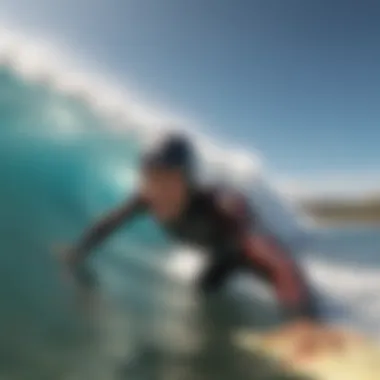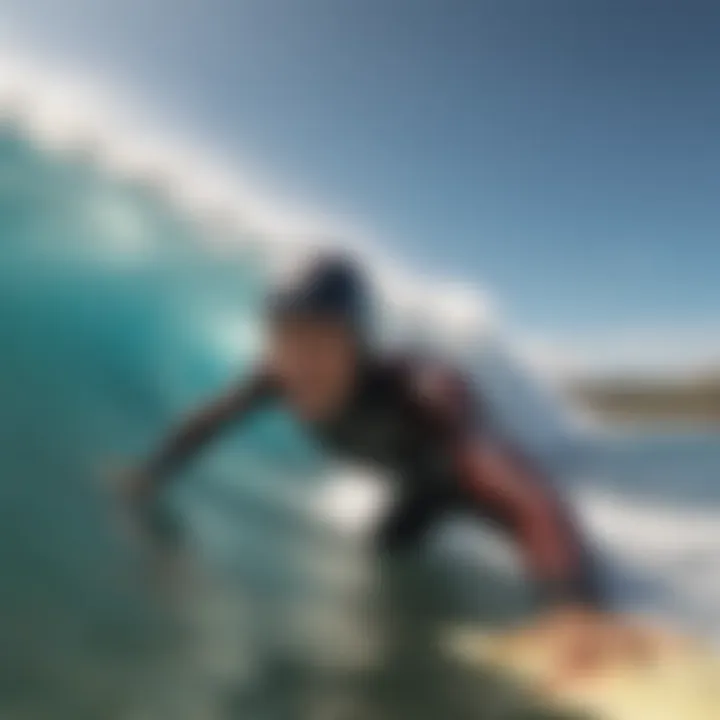Why Surfboard Nose Protectors Are Essential


Intro
Surfing has always been more than just a sport; it’s a lifestyle. It's about riding the waves, feeling the rush of the ocean, and carving your legend into the water. But amidst the thrill, the equipment used plays a critical role, and surfboard nose protectors are often unsung heroes in this narrative. They serve more than just a decorative purpose. Understanding what they are and their significance can make a world of difference in your surfing experience.
Surfboard Reviews
Before diving into nose protectors, it helps to grasp the broad landscape of surfboards. The surfing world encompasses various designs and structures, each tailored for distinct skill levels and surfing styles. Knowing your surfboard type can also shape your choice of a nose protector.
Types of Surfboards: An Overview
When it comes to surfboards, the variety can be staggering. Here are some common types:
- Shortboards: These are about 5 to 7 feet long, designed for experienced surfers looking for agility and performance.
- Longboards: Running anywhere from 8 to 12 feet, these boards provide stability and ease, ideal for beginners.
- Fish: Known for their wider tails and shorter length, they excel in small to medium waves.
- Funboards: These are hybrids between shortboards and longboards, making them versatile for all levels of surfers.
Understanding which surfboard fits your style of surfing allows you to decide on the appropriate nose protector. For instance, if you're frequently riding shortboards, you might prioritize a sleek, aerodynamic nose protector that doesn’t hinder maneuverability.
Best Surfboards for Beginners and Pros
Selecting the right surfboard influences not just your surf experience but also the longevity of your gear.
For beginners:
- Soft-top Boards:
- Often wider and more buoyant, they offer stability.
- Usually made of foam, reducing risks of injury.
For intermediate to advanced surfers:
- Performance Shortboards:
- Cater to those who want agility and speed.
- Made from advanced materials that might require nose protectors more.
Surfing Techniques
The choice of surfing techniques can further dictate the functionality of surfboard nose protectors. Knowing how and where you'll be surfing helps refine your choices in gear.
Essential Techniques for Beginners
It’s crucial for beginners to master basic techniques before they get caught up in the intricacies:
- Paddling: Understanding how to paddle efficiently helps in maneuvering your board.
- Pop-up: The technique of transitioning from lying down to standing is vital for stability.
Advanced Maneuvers for Experienced Surfers
For those seasoned in surfing, there's an entire realm of advanced techniques:
- Bottom Turns: Starting a powerful maneuver, this move sets the tone for tricks.
- Aerials: Requires precision and timing, often necessitating stronger board materials and protective components.
"Taking care of your gear isn’t just about maintenance; it’s about appreciating the sport as a whole. Nose protectors are one way to show love to your board, prolonging its life and enhancing your performance."
The journey of understanding surfboard nose protectors is intricately entwined with the broader landscape of surfing itself. As you immerse yourself in various types of surfboards and the techniques that define the surfing culture, the importance of every minor element, like a nose protector, becomes evidently clear in protecting your investment and enhancing the surfing experience.*
Prelude to Surfboard Nose Protectors
When it comes to surfing, the equipment can often be seen as just a means to an end — a board to ride the waves. However, if you take a closer look at the intricacies of surfboards, you'll find that every part plays a role in ensuring a surfer's performance and enjoyment. This is where surfboard nose protectors come into play. They are no mere accessories; rather, they are essential elements that serve multiple purposes, especially for avid surfers who frequently engage with the ocean's waves.
Definition and Purpose
A surfboard nose protector, at its core, is a protective cover designed to safeguard the nose of the board from damage. It is usually made from materials like foam, rubber, or polymers that can absorb impacts without transferring too much force to the surfboard itself. The primary purpose is simple yet vital: to prevent dings and dents that can occur during transportation, storage, or in the heat of the moment while catching waves.
But the purpose goes beyond mere protection. These nose protectors help preserve the structural integrity of the surfboard, ensuring that its performance characteristics remain uncompromised. Surfers might chase big swells or maneuver through crowded breaks, and ths these protectors act as invisible warriors, defending the board so that surfers can ride without worry.
Historical Context
To appreciate the importance of nose protectors today, it's helpful to touch on their evolution. Early surfboards were primarily made from solid wood. They were cumbersome and often sustained significant damage from constant use and collisions. As surfboard technology advanced in the latter half of the 20th century, materials shifted to lighter fiberglass and foam composites, and the need for protective solutions became evident.


Surfers began experimenting with various forms of nose protection – from DIY solutions using leftover materials to purchasing specialized products from surf shops. Over time, this led to more refined designs that not only served a functional purpose but also catered to aesthetic preferences. Nowadays, a nose protector might come in different styles, colors, and designs, allowing surfers to express their personality while prioritizing durability.
Nose protectors have come a long way since those early days of surfing innovation. They are now viewed as a necessary investment for anyone serious about their sport, leading to inquiries like: How can I install one effectively? What material is best for my board type? As the surf culture continues to evolve, understanding the role of these protectors becomes increasingly vital.
Benefits of Using a Nose Protector
Using a nose protector on your surfboard isn't merely a trend or an accessory; it's a crucial investment in the longevity and performance of your board. As surfers, we're constantly exposed to the unpredictable nature of the ocean, where dings and dents can happen in the blink of an eye. Protecting the nose of our boards can mean the difference between a damaged board that requires costly repairs and a product that allows for endless waves without hindrance. Let’s dive into the benefits that make these protectors so significant.
Protection Against Dings and Dents
The first and perhaps most obvious advantage of securing a nose protector is its superior ability to fend off dings and dents that can wreak havoc on a surfboard. Surfers know all too well the pain of hitting a rock, coral, or even another board, especially during a wipeout. The nose is particularly vulnerable, given its forward position and the way boards are often tossed around in the surf.
By utilizing a nose protector, you create a buffer zone that can absorb shocks. This means fewer repairs and potentially a longer life for your surfboard. Think of it as a gentle nudge between your board and the hard, relentless elements of the ocean – preserving your investment, so you enjoy time on the water instead of at the repair shop.
"In surfing, patience is a virtue, but damage to your board can speed things up in the wrong direction."
Improved Durability of the Board
Besides merely preventing immediate damage, using a nose protector can significantly enhance the overall durability of a surfboard. When the nose is protected, it aids in maintaining the structural integrity of the board. A board that's consistently dinged can lose its shape and responsiveness over time, which can affect performance during crucial moments in the surf.
A nose protector acts like an insurance policy that preserves not just the appearance of the board, but its functional capabilities as well. The better maintained your equipment, the better your surfing experience. Those who have surfed for any length of time know that a performance dip can be just as disappointing as the worst wipeout.
Enhanced Performance Characteristics
Now, you might wonder how a seemingly simple accessory could influence performance characteristics. When a board has a well-maintained nose, it allows for a cleaner entry into the water during paddling and riding. A smooth, intact edge can reduce drag and enhance speed, enabling surfers to catch waves more efficiently.
Additionally, a protected nose helps maintain the balance and overall design of the board. If the nose suffers damage, it may lead to changes in the board's dynamics, resulting in a less enjoyable surfing experience. Surfers can achieve better turns, sharper maneuvers, and higher levels of responsiveness on waves with a board that's in top shape.
In summary, the benefits of using a nose protector boil down to extending the life of your board, enhancing its durability, and promoting optimal performance, all crucial for anyone serious about surfing. The ocean is a beautiful yet chaotic place, and protecting your equipment can make all the difference between an unforgettable ride and a frustrating outing.
Types of Nose Protectors
Understanding the different types of surfboard nose protectors is key to enhancing the longevity and durability of a surfboard. Each type caters to specific needs and preferences among surfers. It’s essential to recognize that the choice of a nose protector might affect not just the board’s lifespan but also its performance in the water. Below we will examine the primary types of nose protectors and what they have to offer.
Foam Nose Protectors
Foam nose protectors have been around for years, providing surfers with an affordable and lightweight option. These protectors are typically made from dense polyethylene foam, providing a cushy buffer that absorbs shocks from minor bumps and scrapes.
One major advantage of foam is its ease of installation; it generally adheres firmly to the board, needing minimal tools. Here are some notable points:
- Shock Absorption: The foam has excellent impact resistance, making it great for daily surfers who encounter natural obstacles like rocks or their fellow surfers in the lineup.
- Weight: Being light, it does not affect the board’s buoyancy significantly.
- Customization: Available in various shapes and colors, foam nose protectors can add a touch of personality to any board.
However, the foam does have its limits. It may not withstand prolonged exposure to sunlight and ocean chemicals which can degrade it. Regular inspection is vital to ensure that the foam protector remains effective and does not peel away from the board.
Rubber Nose Protectors
Rubber nose protectors offer a different set of benefits, especially for those who prioritize durability. Built with a variety of rubber compounds, these protectors are designed to withstand harsh conditions and repeated impacts.
Some distinct features include:
- Durability: The robust nature of rubber enhances longevity, making it an ideal choice for regular surfers who value prolonged use in challenging conditions.
- Flexibility: Rubber offers some give upon impact, allowing for better energy distribution across the board during collisions.
- Water Resistance: The material is typically non-porous, preventing it from absorbing water, which helps in maintaining its structural integrity over time.
Prospective users should note that rubber can sometimes be a bit on the heavier side, which might slightly alter board dynamics. Nonetheless, for those who frequently surf rugged locations, the extra weight can be worth the added protection.
Polymer-Based Nose Protectors
Polymer-based nose protectors stand at the intersection of science and surf technology. Often made from advanced synthetic materials, these protectors bridge the gap between flexibility and resilience, offering a tailored solution for today’s surfers.
Key advantages include:
- Superb Protection: Their engineering allows for exceptional impact resistance, effectively safeguarding the nose of the board against more significant dings.
- Lightweight: Despite their strength, many polymer protectors maintain a low weight, ensuring that the board’s performance isn’t compromised.
- Seamless Integration: Polymer protectors can often be integrated into existing aesthetics of the board without disrupting its design, making it a favorite among surfboard manufacturers.
While polymer options can be pricier than foam or rubber, they are often viewed as a worthy investment for dedicated surfers aiming to protect their board thoroughly. Given their resistance to the elements, this type of protector can serve surfers well over time.
"Choosing the right type of nose protector can not only enhance your board's lifespan but can also contribute to a more enjoyable surfing experience. Your surf gear is your partner in the water; treat it right!"


How to Install a Nose Protector
Installing a nose protector on your surfboard can significantly enhance its longevity and performance, safeguarding it against those pesky dings and bumps that often occur during use. Proper installation is crucial not only for the efficiency of the protector itself but also to ensure that it adheres correctly and functions as intended during your surfing sessions. A well-installed nose protector can help you avoid costly repairs or even the headache of purchasing a new board.
Necessary Tools and Materials
Before diving into the installation, ensure you have the right tools and materials at your disposal. It's like showing up to a party without your favorite drink; everything feels a bit off. Here’s what you'll need:
- Nose protector (the type you prefer, whether foam, rubber, or polymer)
- Sandpaper (preferably in medium grit for smoothing the surface)
- Clear epoxy glue or adhesive (to secure the protector)
- Pencil or marker (for marking positions)
- Ruler or measuring tape (to measure lengths accurately)
- Clean cloth (to wipe off any dust or residue)
Keeping these things ready saves you from fumbling halfway through the installation.
Preparation Steps
Proper preparation can make or break the installation process. Follow these steps to get started:
- Choose Your Spot: Select a clean, flat area with adequate lighting. Good visibility helps to see any imperfections that need addressing.
- Clean the Area: Use a clean cloth to wipe the nose of your board. Removing any dirt or old adhesive is essential; otherwise, the new protector won't stick.
- Sand the Surface: Gently sand the area where the nose protector will be applied. This roughens up the surface and helps the adhesive grip better. A few gentle strokes will do; you don’t want to damage the board itself.
- Measure and Mark: Take your ruler and make precise measurements for where the protector will go. Mark it lightly with the pencil, so it’s easy to see without leaving permanent marks.
By getting these details sorted ahead of time, you can glide through the installation with ease.
Installation Techniques
Now that you're prepared, it's time to dive into the installation itself. Here’s a straightforward approach:
- Apply Adhesive: Squeeze the clear epoxy glue onto the back of the nose protector, covering it evenly. Don’t go overboard; a thin layer usually works best.
- Positioning the Protector: Carefully place the protector in line with your markings. It’s essential to do this step patiently to avoid misalignment.
- Press and Hold: Once positioned, gently press the protector down for a few seconds to ensure a firm grip. If possible, use clamps to hold it in place while it sets; this keeps it from shifting.
- Secure and Set: Allow the adhesive to cure as per the manufacturer’s instructions, generally anywhere from a few hours to overnight, to be on the safe side.
- Final Touches: After the glue has set, give it a final wipe to keep everything neat and tidy, thus ensuring optimal performance.
Remember, a little attention to detail goes a long way. Proper installation not only protects your board but enhances your overall surfing experience.
By following these steps, you can ensure that your surfboard nose protector is installed correctly, allowing you to focus on what matters most—hitting those waves with confidence.
Maintaining Your Nose Protector
When it comes to surfboards, maintaining the integrity of your nose protector is as crucial as the initial purchase itself. A well-cared-for nose protector enhances not only the lifespan of your board but also ensures an optimal surfing experience. Just like any piece of equipment, regular maintenance prolongs its functionality. This section covers the essentials of taking care of your nose protector, focusing on inspection and cleaning strategies.
Regular Inspection
Conducting regular inspections of your nose protector is pivotal. Think of it as a routine check-up for your board. Seasoned surfers often express that a small crack can lead to major issues down the line if it's not addressed early on. By inspecting your nose protector often, ideally before and after surf sessions, you can catch any signs of wear or damage early. Here’s what you should keep an eye out for:
- Visible Damages: Look for cracks, dents, or any other visible damage.
- Adhesion Issues: Ensure that the protector is still firmly attached to the nose of the board and that there are no loose edges.
- Deformation: If the protector has changed shape, it may not provide adequate coverage anymore.
- Material Breakdown: Signs like fading or crumbling indicate that the material is losing its integrity.
Keeping a checklist can make this process smoother. By checking these points systematically, you can save yourself from costly repairs and even a potential board replacement.
Cleaning and Care
Cleaning your nose protector properly is often overlooked but it can significantly affect its performance and longevity. After all those epic rides through saltwater, sand, and possibly reef scrapes, it's essential to treat your board with respect. Follow these care tips:
- Rinse with Fresh Water: After each surf session, rinse the nose protector with fresh water to remove salt and debris. This simple act can prevent buildup that leads to wear.
- Use Soft Cloths: Wipe it down with a soft, non-abrasive cloth. Avoid any harsh scrubbing which can scratch the surface or damage the protector.
- Check for Residues: Check for any wax or other residues that might stick to it. These can trap moisture and lead to material degradation
- Inspect for Mold or Mildew: In humid environments, mold can become an unwelcome guest. If you notice persistent mold, a gentle cleaning solution specifically designed for surfboards can help.
- Drying: Always let the nose protector dry completely before storing the board. A damp environment is a breeding ground for mold and mildew, which can harm not only the protector but the entire board.
Lastly, some surfers swear by using UV protectant sprays designed for surfboards. These sprays can help shield the nose protector from the sun’s UV rays, preventing premature aging. Just ensure you're not spraying directly on your board but rather applying it to a cloth first.
"Taking care of your nose protector is like taking care of your surfboard’s health. Small efforts in maintenance yield big results in performance."
Engaging in regular inspections and proper cleaning will keep your nose protector in tip-top shape, ensuring you can ride those waves without a hitch. In combination, these practices secure not just the equipment but also enhance your entire surfing experience.
The Economic Impact of Nose Protectors
When surfers consider the longevity of their gear, nose protectors often don't spring to mind initially. Yet, they play a subtle yet consequential role in how surfers invest in their equipment. Understanding the economic impact of these accessories can shed light on their overall value in the surfing community.
Cost-Benefit Analysis
The cost-effectiveness of nose protectors can be seen when diving into a simple analysis. Initially, the price of a decent nose protector might raise a few eyebrows. However, when one considers the potential expenses involved by neglecting this small piece of equipment, the numbers can start to favor its inclusion.
For example, the anticipated costs of repairing a dinged surfboard—which might arise from chip damage during transport or accidental collisions—can easily throw a wrench in surfers’ budgets. Here’s a quick breakdown of potential costs:
- Repair Costs: A simple ding repair could be around $50 to $100, depending on board type.
- Board Replacement: In case of severe damage, a new board ranges from several hundred to thousands of dollars.
- Time Off the Water: Consider the lost opportunities to surf during the repair time, which can be both frustrating and costly in lost sessions.


So, the question becomes: why risk extensive repairs when a nose protector could serve as a wall against such damage? By investing anywhere from $10 to $50 into a protector, surfers can plague themselves with fewer worries and heaps of savings down the road. This is how effective a cost-benefit analysis can be.
Market Trends and Consumer Behavior
A glance at market trends shows increasing awareness among surfers regarding the importance of gear maintenance. Nose protectors have increasingly entered conversations amongst retailers and consumers alike. Many brands are now emphasizing sustainability and durability, tapping into those concerns from surf enthusiasts. Surfboard nose protectors are being designed with not only aesthetics but also practical long-lasting benefits in mind.
Additionally, consumer behavior has shifted with increased accessibility to information. Surfers often find themselves delving into forums, like reddit.com, discussing best practices and experiences. This community-driven insight allows for more informed decisions when it comes to purchases—creating a ripple effect in how quickly new surfers adopt protective gear.
In fact, buyers often inquire about additional protection while purchasing their boards, showcasing a keen awareness of the value behind preventive measures. As more surfers share experiences and testimonials, it encourages newer generations to follow suit, cultivating a market trend where nose protectors become, dare I say, a normative part of a surfer's setup.
"Investing a little upfront saves a lot down the line; it’s all about playing the long game in this sport."
Environmental Considerations
In recent years, the conversation surrounding environmental sustainability has risen to the forefront of nearly every industry, surfing included. Huge swathes of ocean and coastal ecosystems are at risk due to pollution, climate change, and overconsumption. As such, the choice of materials used in surfboard accessories, like nose protectors, becomes increasingly vital. Understanding the link between surfboard maintenance and environmental health is essential for surfers who wish to minimize their ecological footprint while enjoying their passion.
Sustainable Materials in Manufacturing
When it comes to creating effective nose protectors for surfboards, the materials used can have a significant impact not only on the product's performance but also on the environment. Traditional materials like styrofoam or certain plastics can take hundreds of years to decompose. Surfers and manufacturers are gradually turning their eyes toward sustainable alternatives. Some companies have begun experimenting with natural rubber, recycled polyurethane, or even plant-based materials that offer similar levels of protection without the ecological baggage.
Consider the statistics:
- Natural Rubber: Sourced from rubber trees, it can decompose much faster than synthetic alternatives, thus reducing landfill waste.
- Recycled Materials: Using waste products not only cuts down on new resources needed but also helps to lessen the burdens on waste disposal systems.
- Bio-based Plastics: Made from corn or sugarcane, these can be a responsible choice as they are generally more biodegradable compared to conventional plastics.
Switching to these sustainable materials not only meets the protective needs of surfboards but also fosters a culture of responsibility. Choosing products manufactured from eco-friendly materials can also inspire other surfers to make noticeable changes, contributing to a larger movement within the sport.
End-of-Life Options for Protectors
So what happens when a surfboard nose protector has worn out? Instead of tossing it into the trash, where it will sit inconspicuously in a landfill for eons, environmentally conscious surfers have a few options at their disposal. Proper end-of-life strategies can drastically change the ecological narrative.
- Recycling Programs: Some brands are starting to implement take-back programs for their products, turning used nose protectors back into usable materials. These initiatives not only promote recycling but also demonstrate corporate responsibility.
- Repurposing: Instead of discarding a worn-out nose protector, some surfers have turned them into other useful items, such as art projects, keychains, or even protective gear for different sports, showcasing creativity and resourcefulness.
- Composting: Depending on the materials used, some nose protectors can even be composted. For instance, those made from natural materials like cork or rubber could enrich garden soil, bringing life back into the earth.
"Choosing sustainable products empowers individuals to make impactful changes, reducing waste and promoting environmental awareness."
Realizing the importance of sustainable products and recycling can lead to a broader spectrum of ecological impacts and lifestyle changes among surfers. Becoming an informed consumer not only enhances the individual surfing experience but can also resonate within local and global communities. In this era of climate consciousness, making thoughtful choices can have ripples well beyond the waves.
Personal Experiences and Testimonials
Sharing personal experiences and testimonials regarding surfboard nose protectors adds a unique layer of understanding to their significance. This section emphasizes real-life stories and insights from surfers who have integrated nose protectors into their surfing gear. These perspectives help shed light on how these simple devices impact the sport and the overall experience in the water.
Surfers Who Use Nose Protectors
Many surfers have found that using a nose protector can make all the difference, especially during intense sessions or when riding powerful waves. For instance, Jason, a surfer from California, recounts how his foam nose protector saved his board from a nasty ding while he was navigating a particularly challenging reef break. He states, "The first time I hit the rocks, I thought my board was done for. But the nose protector absorbed the impact, and my board came out practically unscathed. Since then, I wouldn’t hit the waves without it."
Similarly, Melissa, a junior surfing instructor, echoes Jason’s sentiments.
"I always recommend nose protectors to my students. It not only keeps the boards looking fresh but also gives them confidence to push their limits. Nobody wants to experience that gut-wrenching moment when they see a new crack on their board after a wipeout."
Such experiences highlight the practical benefits of using nose protectors, reflecting on prevention over repair. It’s not just about aesthetics; it’s about preserving the integrity and performance of the surfboard as well.
Impact on Surfing Performance
The anecdotal evidence from surfers often underscores another critical component – performance. Surfers consistently report that the confidence gained from knowing their boards are well-protected enhances their overall experience. Jason mentions, "When I know I have my nose protector on, I ride with a different mindset. I’m willing to go for those bigger waves without second-guessing my gear."
Moreover, the materials used in nose protectors can influence not just durability but also performance metrics like buoyancy and maneuverability. Surfers like Melissa note:
- Enhanced Control: The protective layer often provides additional grip when paddling, allowing them to better control their surfing maneuvers.
- Confidence to Experiment: Knowing that their boards can withstand the rigors of deep surfing encourages surfers to experiment with their techniques without the fear of damage.
- Wipeout Resilience: Nose protectors are especially valuable during wipeouts. They can lessen damage that typically occurs during those chaotic moments after a fall, ensuring that surfers return to the lineup with a board that remains in top shape.
The shared testimonials from seasoned surfers showcase how the experience of using nose protectors extends beyond mere functionality; it fundamentally alters their engagement with their sport. By reinforcing the relationship between equipment and performance, these stories foster a deeper appreciation for surfboard maintenance and the thoughtful use of protective gear.
The End
The discussion surrounding surfboard nose protectors cannot simply be brushed aside as jargon of the surfing community; it holds substantial weight in understanding how we can optimize our surfing experience while preserving our beloved boards. Nose protectors play a pivotal role, from shielding against unpredictable dings and dents to enhancing performance through improved aerodynamics and reduced water resistance. Their value extends beyond mere protection, touching on aspects like sustainability and economic benefits as a wise investment in long-term surfboard care.
Recap of Key Points
- Protection from Damage: Nose protectors can significantly minimize damage from impacts, which is often caused by careless handling or collisions with other surfers or equipment. This means less time in the repair shop and more time riding the waves.
- Increased Durability: By reducing wear and tear, these protectors contribute to the overall longevity of the surfboard. The expense of a new board is not trivial, so extending the life of your current one makes practical sense.
- Performance Enhancement: Many surfers have noted improved maneuverability and flow when their boards are equipped with nose protectors. This aspect shouldn't be overlooked, particularly for competitive surfers who aim for every possible edge.
- Environmental Considerations: With numerous brands now exploring sustainable materials, choosing eco-friendly nose protectors can be a small but impactful step toward greener surfing.
- Diverse Options: From high-density foams to polymers, selecting the right type of nose protector gives surfers the flexibility to choose based on their specific needs and style.
Final Thoughts on Usage
As you consider incorporating a nose protector into your gear, it’s essential to view it not just as an accessory but as a fundamental component of your surfboard setup. Regular maintenance and periodic inspections can further ensure that it performs effectively. In the long run, you're not only investing in the longevity of your equipment but also ensuring a seamless surfing experience, free from interruptions caused by unforeseen mishaps. Choosing a nose protector tailored to your surfing style, whether it be casual or competitive, could very well be the difference between an average outing and a remarkable one. So, why not take that simple step today? The waves are waiting.















